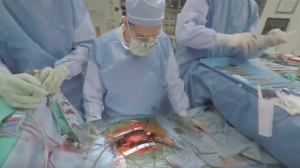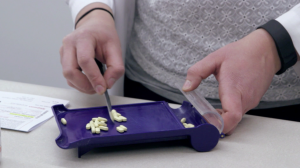NEW YORK (Reuters Health) – Recovery is faster after anterior cruciate ligament (ACL) reconstruction when standard rehabilitation is enhanced with neuromuscular electrical stimulation delivered by an integrated thigh-sleeve device, a German study shows.
Writing in the American Journal of Sports Medicine online February 22, Dr. Sven Feil, with the ATOS Clinic Centre Heidelberg, and colleagues note that recent evidence indicates that rehabilitation after ACL surgery is better when voluntary muscular contractions are combined with neuromuscular electrical stimulation (NMES).
“Conventional lead-wired NMES devices such as Polystim (Biomedical Research, Neurotech, Galway, Ireland) can be effective,” they write. “However, setup can be inconvenient because each of the 4 electrodes has to be attached to a lead wire, which then must be correctly located by the patient on the skin for each treatment.”
These drawbacks are addressed by the Kneehab device (also made by Biomedical Research Ltd), which “integrates the electrodes and wiring into a garment that can be applied and removed in seconds.” It also has larger electrode surfaces, allowing for higher currents without increasing discomfort.
The researchers compared outcomes of a standard ACL rehabilitation with or without the addition of the neuromuscular stimulator devices. Of 131 ACL patients recruited for the study, ultimately a control group of 34 patients performed volitional quadriceps exercises without neuromuscular electrical stimulation, while 33 completed the same training with the Kneehab device, and 29 did so with the Polystim device.
The primary outcomes were knee extensor strength, the ability to jump on one leg (single-legged jump), and the time to complete the shuttle run.
At 6 months follow-up, the gain in extensor strength in the Kneehab group at speeds of 90 and 180 degrees per second increased by 30.2% and 27.8%, respectively, over preoperative values. Corresponding changes in the Polystim group were 5.1% and 5.0%, and for the control group they were 6.6% and 6.7%, the investigators report.
“The mean single-legged hop test score of the Kneehab group improved by 50% between the 6-week and 6-month follow-up visits, whereas the corresponding changes for the Polystim and control groups were 26.3% and 26.2%, respectively,” according to the report .
Dr. Feil and colleagues conclude that, while all patients improved, those in the Kneehab group achieved consistently better results. “In addition, the Kneehab patients achieved higher rates of compliance than with conventional neuromuscular electrical stimulation, progressed faster, and were able to return to their usual work activities 7 days sooner than did both the control and Polystim groups.”
Reference:
The Effectiveness of Supplementing a Standard Rehabilitation Program With Superimposed Neuromuscular Electrical Stimulation After Anterior Cruciate Ligament Reconstruction: A Prospective, Randomized, Single-Blind Study
Am J Sports Med 2011.




